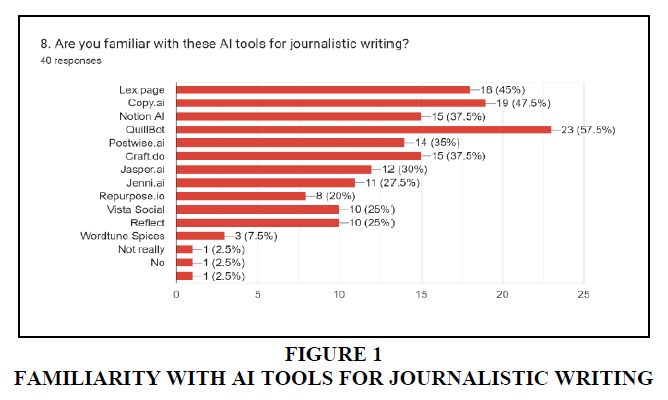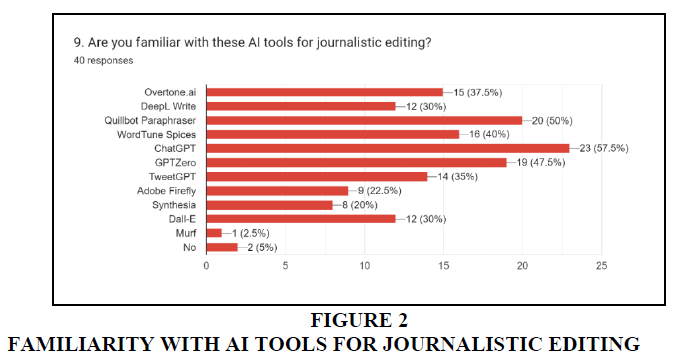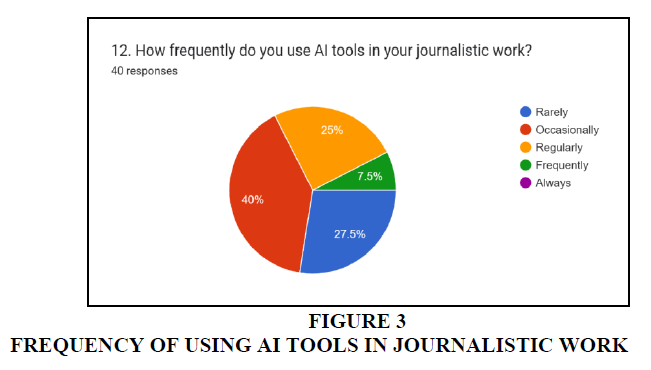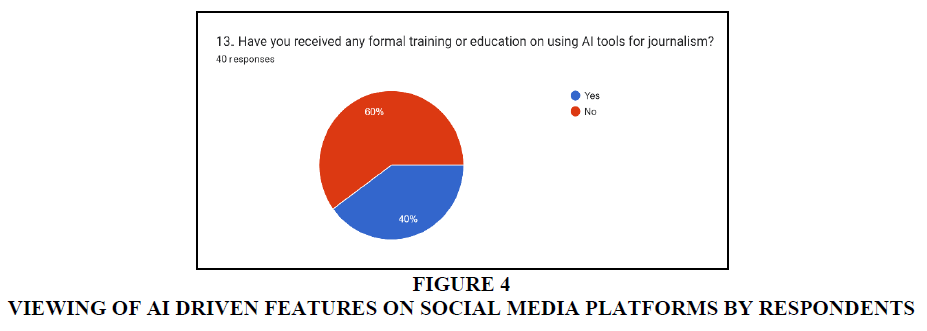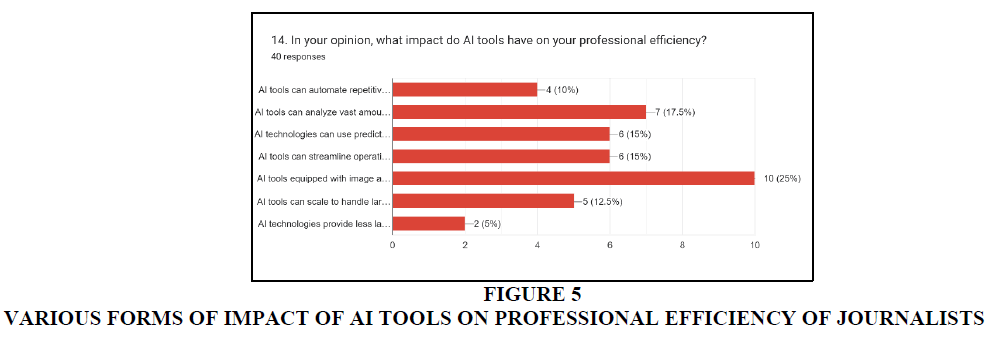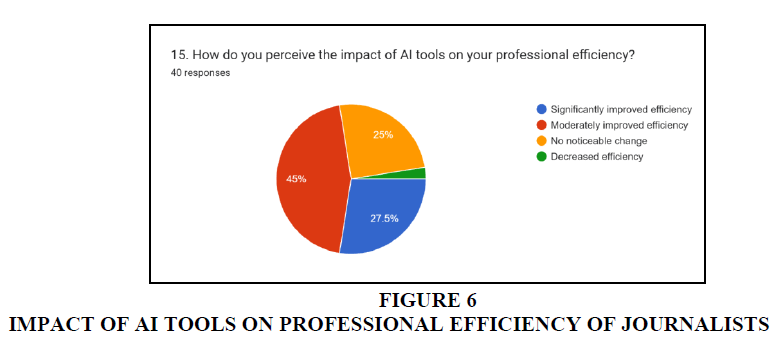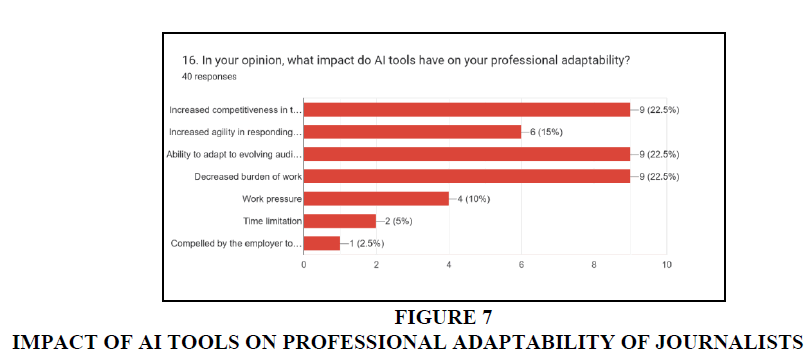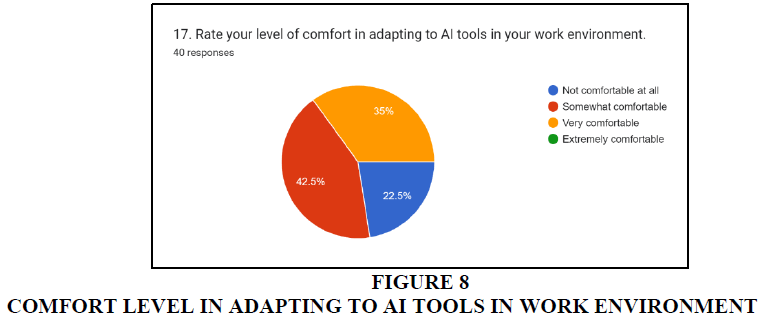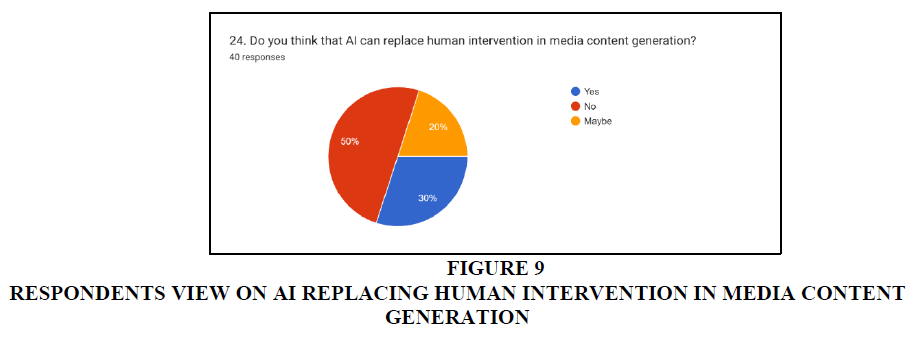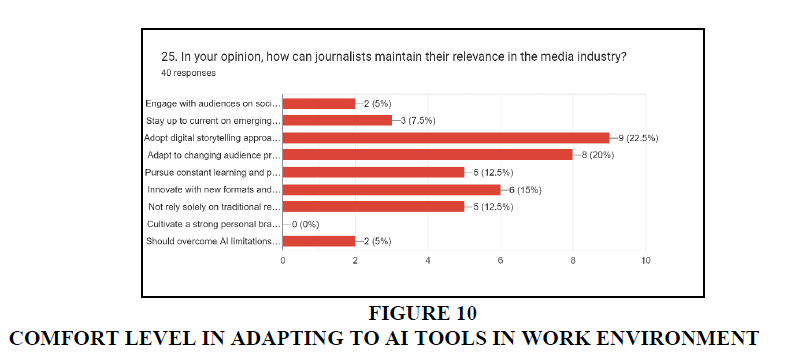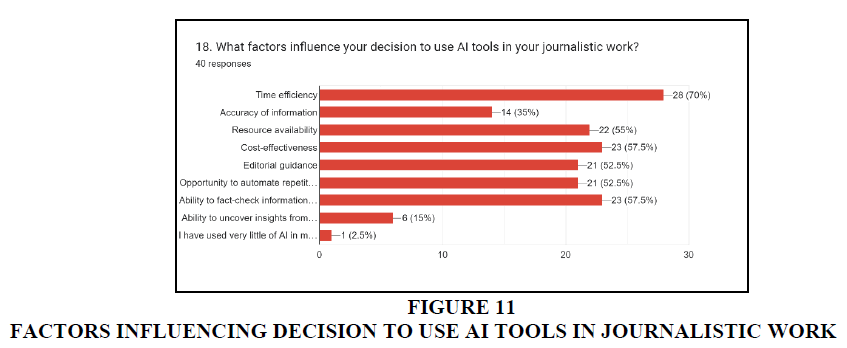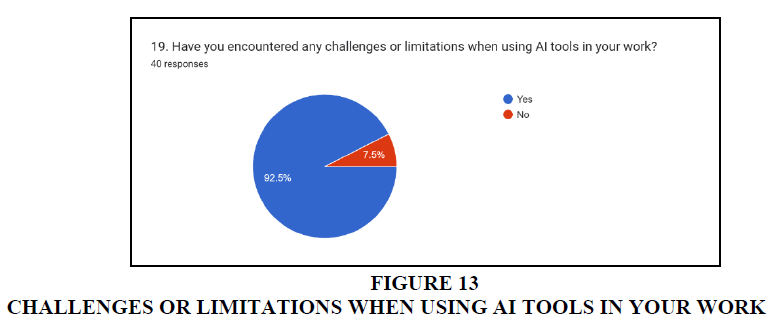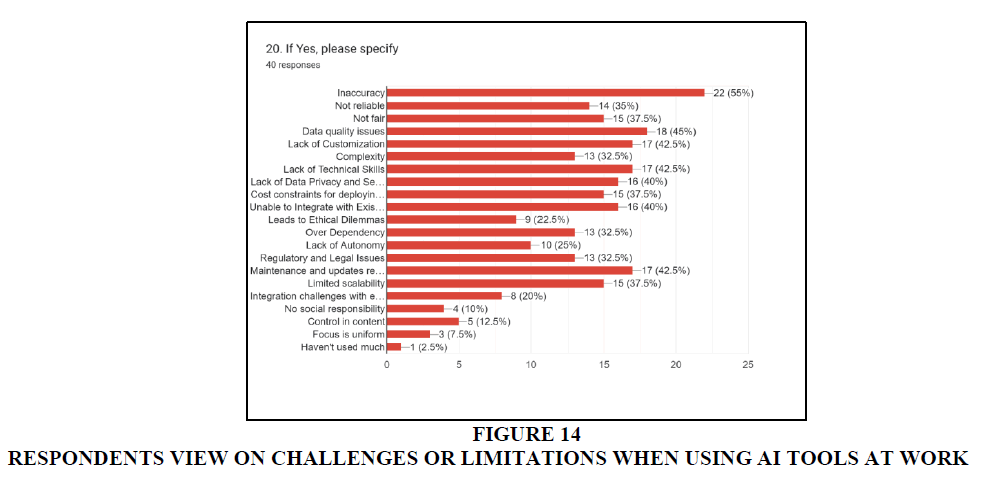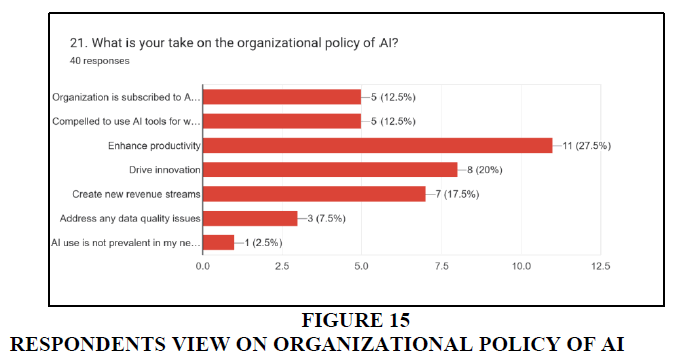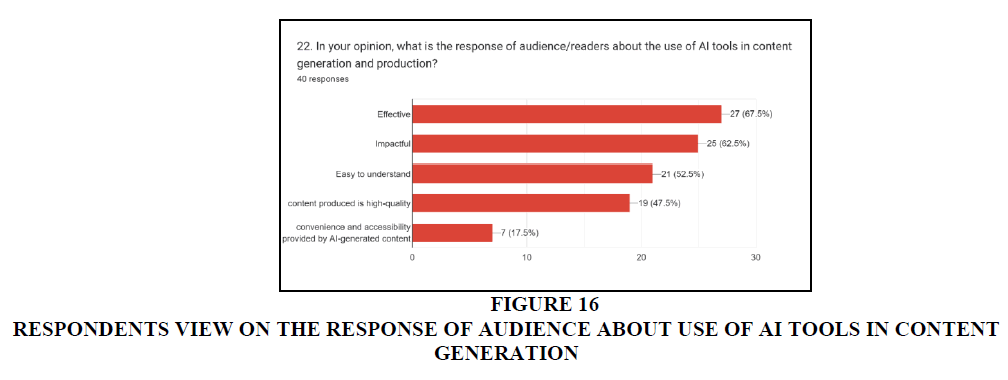Research Article: 2025 Vol: 29 Issue: 2
Impact of Ai Tools on Professional Efficiency of Journalists: A Study among the Print and Electronic Media Journalists in Karnataka.
Meghna Ghosh, Bangalore University, India
Citation Information: Ghosh, M. (2025). Impact of ai tools on professional efficiency of journalists: a study among the print and electronic media journalists in karnataka. Journal of Organizational Culture Communications and Conflict, 29(2), 1-13.
Abstract
In an era marked by rapid technological advancement, the landscape of journalism has witnessed significant transformations. With the advent of Artificial Intelligence (AI) tools, journalism practices have evolved, presenting both opportunities and challenges for professionals in the field. The integration of AI tools in journalism has brought about notable shifts in the way information is gathered, analysed, and disseminated. As AI continues to redefine the parameters of journalistic practice, there is a growing imperative to equip journalists with the necessary skills, knowledge, and ethical frameworks to navigate the evolving media landscape responsibly. The investigation on the influence of AI tools on the professional productivity of journalists in Karnataka reveals a complex landscape defined by technology integration, shifting practices, and various perspectives within the journalistic community. The study highlights the growing use of AI tools by journalists in Karnataka, with the majority of professionals using various applications for jobs ranging from data analysis to content selection and creation. This extensive usage shows an understanding of AI's ability to improve productivity, streamline procedures, and expand journalistic talents. The specific objectives are to know the frequently used AI tools for various job roles in media houses. To identify adaptability to AI environment in media and its impact on professional efficiency. To measure the various adaptability of AI tools for work delegation. To know the factors affecting the use of AI tools in journalistic work. The present research adopted qualitative and quantitative research methods to address the objectives. The survey with questionnaire will be used for primary data collection. Literature reviews will be extensively used to know AI tools available for journalist. The present research is based on uses and gratification theory by Katz and Blumler (1974). The present study contributed to deeper understanding of the impact of AI tools on the journalistic profession, offering valuable insights for practitioners, media organizations, policymakers, and educators alike along with shaping the future of media and communication in the digital age.
Keywords
Artificial Intelligence, AI tools, professional efficiency, print media, electronic media, journalism, work delegation.
Introduction
The fast development of artificial intelligence has had a profound influence on a variety of sectors, including media. In the field of journalism as AI-powered technologies grow increasingly popular in newsrooms, it is critical to examine their impact on journalists' professional productivity, particularly in the context of print and electronic media in Karnataka (García, et al., 2021). Artificial intelligence has been progressively expanding over the last decade, with its transversal application to the journalistic process and the engaging of media and technology companies in developing specific tools and services (Sánchez-García et al., 2019). Research indicates that AI can improve journalist productivity by automating jobs like information collection, article creation, and audience analysis (Heim & Chan-Olmsted, 2023). However, incorporating AI-based technologies into journalistic workflows is not without problems, as it necessitates careful evaluation of the influence on newsroom values, routines, and socio-cultural experiences (Lopez et al., 2022). Several countries, including Spain, have seen the development of AI systems for journalism, with companies and institutions developing tools and services for different stages of the process (Sánchez-García et al., 2023). The first applications of automated journalism occurred in the United States in 2014, with the creation of Quakebot, which automatically reported earthquakes in the Los Angeles Times (Carlson, 2018), and in The Associated Press reports on the Automated Insights' Wordsmith platform (Graefe, 2016), which also automatically writes sports articles (Tejedor-Calvoet al., 2021). The same year, the French daily Le Monde employed the Data2Content AI system to create micro-news on election outcomes. Many analyses of the relationship between journalism and AI focus on weak (or narrow) AI, which treats news production as a machine that only performs pre-programmed tasks (Graefe & Bohlken, 2020). AI is now being used in many aspects of news production, beyond just automated textual content. AI is rapidly being used to simulate human-like information processing and problem-solving abilities. (Túñez et al., 2021).
Literature Review
Review of literature found that the influence of AI on journalism, including news-making processes, media routines, and ethical concerns. AI aids newsrooms by improving journalist capabilities, saving time, and increasing productivity in the mass media business. The report highlights the importance of changing mindsets in the media industry and emphasizing AI training to address workers' lack of understanding. Ethical challenges raised by the use of AI highlight the significance of constant control and monitoring of AI processes in journalism (Noain-Sánchez, 2022).
The literature review examines the impact of AI on journalism and media consumption in Kazakhstan, raising worries about its influence on information distribution. The experiment highlights the novelty and significance of distinguishing between AI-authored writings and those produced by actual journalists, highlighting a gap in the scientific literature. The study tries to discriminate between journalistic and robotic writings, helping to understand consumer preferences for media content development. Kazakhstani media consumers prefer human-authored texts over AI-generated ones, demonstrating reluctance to include AI in mass media due to perceived quality difficulties (Habaršy 2022).
Studied how AI is transforming the news creation process and media structure. The article explores how AI might expand automated text news to audio and video forms, allow for non-linear consumption, and modify business models and audience interaction tactics. The research predicts that journalists' professional duties would change, with a focus on cognitive contributions to news creation rather than operational tasks. Additionally, the study discusses the issues faced by false news in journalism, emphasizing the significance of education, source verification, and trustworthiness in combatting disinformation.
The literature review discusses how integrating AI literacy and ChatGPT-3 might improve critical thinking and journalistic writing abilities among students. It emphasizes the growing relevance of AI in a variety of industries, including media, and the advantages of incorporating AI technologies into journalism education. The findings highlight the importance of AI literacy in preparing students for the future AI-centric media sector by encouraging in-depth study and cooperation in the classroom (Irfan et al., 2023).
The study paper examines the influence of Artificial Intelligence (AI) on the Indian media sector, including efficiency, cost-effectiveness, customization, multilingual news creation, real-time news generation, and disinformation prevention. Times Now, India's leading news channel, has used AI to automate news creation, demonstrating the practical application of AI in the media business. The study focuses on AI's potential to write news stories in different languages, provide real-time news, battle disinformation, and improve efficiency and cost-effectiveness. The report also underlines the need of considering obstacles such as employment losses, ethical problems, and the need for greater knowledge, data, and infrastructure when applying AI in the Indian media sector (Ashfaq et al., 2023).
In the review of literature (Iyinolakan, 2023) found that the application of AI technology in journalism training in Nigeria, specifically for indigenous languages, to improve media coverage. The absence of research on incorporating AI into journalism education in Africa emphasizes the need for more exploration of the benefits and limitations of employing AI technologies in journalism pedagogy (Kaur & Ashfaq, 2023). The study argues that using AI technologies in journalism education can improve quality, empower journalists with digital skills, and encourage inclusion of indigenous populations in media output. It advocates for a dynamic curriculum free of bureaucracy to teach both aspiring and experienced journalists, highlighting the significance of financing for the implementation of new AI technologies in journalism education (Noain Sánchez, 2022).
The research study report explores how professionals and academics see the use of artificial intelligence in journalism. The article stresses that AI will not negatively affect the media employment market and underscores the need for comprehensive journalist training that incorporates developing technology. The survey found that many students lack formal instruction on AI, emphasizing the need for thorough training for future journalists to integrate developing technology. It also highlights the necessity for media businesses to embrace innovation, and for Communication and Journalism colleges to modify their curricula to suit the changing demands of the labour market driven by technology (Ufarte-Ruiz et al., 2023).
Scope of Study
The study aims to assess the impact of Artificial Intelligence (AI) tools on the professional efficiency of journalists in Karnataka, focusing on both print and electronic media. It will explore how AI technologies are being utilized in journalistic practices, their effectiveness, and their influence on the quality and efficiency of journalistic work.
Statement of Problem
The introduction of artificial intelligence (AI) has ushered in a new age for several sectors, including journalism. AI tools have the potential to transform how journalists conduct research, create content, and communicate with their audiences. However, incorporating AI into journalistic practices raises a number of concerns and uncertainties, particularly about its impact on professional efficiency, content quality, and the ethical dimensions of news production. This study aims to address these issues by assessing how AI technologies affect the professional effectiveness of print and electronic media journalists in Karnataka. It seeks to give a thorough grasp of how AI affects their everyday work, the quality of the material they create, job happiness, and the ethical concerns they must navigate. By investigating these characteristics, the study hopes to provide insights that might drive future methods for incorporating AI into journalism, ensuring that technology improvements benefit the sector while adhering to journalistic norms and ethic.
Objectives
• To know the frequently used AI tools for various job roles in media houses.
• To identify the status of AI environment in media and its impact on professional efficiency.
• To measure the various factors influencing the adaptability of AI tools for work delegation.
• To know the factors affecting the use of AI tools in journalistic work
Theoretical Perspective
According to Katz, Blumler, and Gurevitch, the three uses and gratifications thesis is predicated on three essential ideas. 1) Viewers are goal-oriented in their behaviour, 2) they are active media consumers, and 3) they are aware of their wants and choose media to meet them. The study used Uses and Gratification theory to understand various gratifying factors for using AI in journalism.
Methodology
The present research adopted quantitative research method to address the objectives. Survey with questionnaire was used for primary data collection. The convenient sampling method was used to select the respondents. The sample size is 40, due to time limitation. Qualitative research method was used to know and understand the various AI tools available in the field for journalists.
Data Analysis and Interpretation
The data was collected from 40 respondents. Among 40 respondents 6 were female and 34 were male. The most common age group is 20-30, which accounts for 72.5% of respondents. Majority of the respondents 32.5% are in their professional domain are reporters followed by video editors 15% and 15% photojournalists. Among the 40 respondents, 22.5% have minimum of 2 years of experience in their field while 17.5% have 3 and 4 years of experience in their respective domains.
Majority of the respondents 40% are somewhat familiar with the artificial intelligence (AI) tools used in journalism. Nearly 32.5% of the respondents are neutral about their familiarity with the AI tools while only 22.5% of the respondents are very familiar with the tools. Among the respondents, majority 52.5% have not used AI tools for their journalistic work while only 47.5% have used it.
The Frequently Used AI Tools for Various Job Roles in Media Houses
Among the respondents, it can be observed that majority of the respondents 57.5% are familiar with Quillbot AI tool for journalistic writing, 47.5% are familiar with Copy.ai and 45% are familiar with Lex.page. 37.5% of the respondents are familiar with Notion AI and Craft.do tools while 35% are familiar with Postwise.ai and 30% are familiar with Jasper.ai for the journalistic writing Figure 1.
It can be observed that among the respondents 57.5% are familiar with ChatGPT AI tool for journalistic editing, 50% are familiar with Quillbot Paraphraser and 47.5% are familiar with GPT Zero. Among the respondents 40% knows about AI tools such as Word Tune spices, 37.5% are familiar with Overtone.ai, 35% knows about TweetGpt and only 30% are familiar with Fall-E and DeepL Write for journalistic editing Figure 2.
Most of the respondents 40% occasionally use AI tools in their journalistic work, 27.5% agreed to use it rarely whereas only 25% are believed to be using AI tools on a regular basis in their journalistic work. believe that AI technologies have influenced the political content they have encountered on social media, 18% of respondents said no and 14.8% that are not sure Figure 3.
The Adaptability to AI Environment in Media and Its Impact on Professional Efficiency
Majority of the respondents 25% believe that AI tools equipped with image and speech recognition capabilities can automate tasks leading efficiently handle multimedia content Figure 4, 17.5% agree that AI tools can analyse vast amounts of data quickly and accurately, 15% of the respondents believe that AI technologies can use predictive analytics algorithms to forecast trends and AI tools can streamline operations through workflow analysis. Whereas 12.5% of the respondents think that AI tools can scale to handle large volumes of data and only 10% of the respondents think that AI tools can automate repetitive and time-consuming tasks Figure 5.
Among the respondents 45% believe that AI tools have moderately improved the professional efficiency, 27.5% agree that it has significantly improved their efficiency whereas 25% agreed that there is no noticeable change Figure 6.
22.5% of the respondents strongly believe that the impact of AI tools on professional adaptability includes decreased burden of work, ability to adapt to evolving audience preferences and behaviours and increased competitiveness in the field, 15% believe that one of the impact includes increased competitiveness in the field whereas only 10% believes it to be work pressure Figure 7.
Among the respondents 42.5% are somewhat comfortable in adapting to AI tools in the work environment, 35% of the respondents are very comfortable whereas only 22.5% are not comfortable at all Figure 8.
Majority of the respondents 50% completely disagree with the statement that AI can replace human intervention in media content generation, 30% agree that in future AI can replace human intervention in media content generation and only 20% are not sure Figure 9.
Among the respondents, majority 22.5% believes that adapting to digital storytelling approaches a journalist can maintain their relevance in the media industry. 20% among the respondents feels that a journalist should adapt to changing audience preferences and consumption habits to maintain their relevance. 15% believes that they should innovate with new formats and platforms whereas 12.5% believes that they should not rely solely on traditional reporting methods as well as pursue constant learning and professional growth Figure 10.
Measuring the Various Adaptability of AI Tools for Work Delegation
Among the respondents, majority of the responses that measure the various adaptability of AI tools for delegation points to time efficiency which is 70%. Respondents who believe Cost-effectiveness and Ability to fact-check information quickly and accurately is 57.5%. Resource availability 55%, opportunity to automate repetitive tasks and editorial guidance 52.5% and accuracy of information 35% received less agreement by the respondents Figure 11.
60% of the respondents are neutral about their view on the job threat in the organization due to AI adaptability, where only 20% believe and agree to that factor and only 15% completely disagree with the fact that there will be job threat in the organization due to AI adaptability Figure 12.
Factors Affecting the Use of Ai Tools in Journalistic Work
The largest portion of the respondents 92.5% agreed that they have encountered challenges or limitations when using AI tools in work whereas only 7.5% of the respondents disagreed with the statement Figure 13.
A significant proportion of respondents 55% agreed to inaccuracy as the major factor of the limitation while using AI tool in workplace or work. 45% expressed their concern about the data quality issues as one of the challenges. 42.5% believe that lack of customization, lack of technical skills and maintenance and updates required for AI models as of the crucial factors of limitations of using AI tools in the work. 40% of respondents expressed concern that they are unable to integrate with existing workflows as well as there is lack of data privacy and security. 37.5% respondents felt that AI tools are not fair, cost constraints for deploying AI solutions and there is limited scalability. 35% of the respondents feel that AI tools are not at all reliable. 32.5% believes that using AI tools will result in over dependency, facilitate regulatory or legal issues and it is very complex in nature Figure 14.
27.5% respondents believed AI can enhance productivity. 20% of the respondents felt that AI can drive innovation. 17.5% respondents felt that AI can create new revenue streams. 12.5% believed that they are compelled to use AI tools for work as well as their organization is subscribed to AI tools. Only 7.5% of the respondents felt that AI address any data quality issues Figure 15.
A significant portion of respondents 67.5% reported using AI tools in content generation and production the response of the audience or readers are very effective. 62.5% of the respondents feels it creates impact among the audience or the readers. 52.5% feels that content generated or produced with the use of AI tools are easy to understand. 47.5% of the respondents believe that the content produced is of high quality. Only a small percentage of respondents 17.5% feels that the convenience and accessibility provided by AI-generated content as one of the responses of the audience about the use of AI tools in content generation and production Figure 16.
Conclusion
The assessment of the influence of AI technologies on the professional efficiency of journalists in Karnataka, which includes both print and electronic media, yields notable findings. According to the survey, while 40% of journalists are somewhat familiar with AI technologies, there is still a significant amount 32.5% who are indifferent and 22.5% who are very knowledgeable. This suggests that journalists have a varied level of understanding and experience in AI. The survey's professional roles show that reporters make up the vast majority, with video editors and photojournalists also making important contributions. This diversity highlights AI techniques’ extensive application across many journalistic roles. Despite the potential benefits, more than half of respondents 52.5% have yet to integrate AI technologies into their job, indicating possible impediments such as a lack of training or access. For the 47.5% who have used AI tools, it appears that these technologies are beginning to affect journalistic methods, perhaps increasing efficiency in news collecting, editing, and content development. The diverse degrees of expertise, with many having 2 to 4 years in the field, point to a workforce that might substantially benefit from focused AI training programs. A sizable 67.5% of respondents reported using AI technologies, with 62.5% recognizing their efficacy at engaging audiences. More over half of the respondents 52.5% feel AI- generated material is easier for consumers to grasp, with 47.5% describing it as high-quality. However, just 17.5% see ease and accessibility as important advantages of AI solutions. The analysis of the use of AI technologies in journalistic workplaces in Karnataka uncovers numerous important limits and concerns among participants. The majority 55% see inaccuracy as a big concern, showing a significant obstacle to AI adoption. Furthermore, 45% of respondents refer to data quality issues, highlighting the importance of dependable and high-quality datasets. 42.5% of respondents expressed concerns about a lack of customization, technical skills, and the requirement for frequent maintenance and upgrades, implying that these limitations delay the efficient use of AI solutions. 40% of participants reported integration challenges with existing procedures, as well as data privacy and security concerns, indicating significant areas for improvement. The diverse degrees of expertise, with many having 2 to 4 years in the field, point to a workforce that might substantially benefit from focused AI training programs. A sizable 67.5% of respondents reported using AI technologies, with 62.5% recognizing their efficacy at engaging audiences. More over half 52.5% feel AI-generated material is easier for consumers to grasp, with 47.5% describing it as high-quality. However, just 17.5% see ease and accessibility as important advantages of AI solutions. The majority of respondents 70% cite time efficiency as the most significant benefit of utilizing AI tools, implying that these technologies significantly increase productivity by saving time. Cost-effectiveness and the capacity to fact-check material quickly and properly are also major considerations, with 57.5% of respondents acknowledging these advantages. Resource availability 55% and the capacity to automate repetitive work and give editorial help 52.5% are viewed as additional benefits, but with significantly less emphasis. Notably, just 35% of respondents consider information accuracy to be a significant benefit, reflecting some uncertainty regarding the dependability of AI-generated material. These findings imply that AI techniques are widely regarded to improve content clarity and quality, resulting in increased audience engagement. Nonetheless, there is opportunity to raise awareness of the broader benefits of AI, such as convenience and accessibility, in order to maximize its influence on journalism in Karnataka.
References
Carlson, M. (2018). The robotic reporter: Automated journalism and the redefinition of labor, compositional forms, and journalistic authority. In Journalism in an era of big data (pp. 108-123). Routledge.
García, P. S., García, M. R., & Gracia, A. D. (2021). La enseñanza del Periodismo en la Escuela Oficial franquista (1941-1975) analizada por sus ex alumnos. Ámbits. Revista internacional de comunicación, (54), 38-56.
Graefe, A. (2016). Guide to automated journalism.
Indexed at, Google Scholar, Cross Ref
Graefe, A., & Bohlken, N. (2020). Automated journalism: A meta-analysis of readers’ perceptions of human-written in comparison to automated news. Media and communication, 8(3), 50-59.
Indexed at, Google Scholar, Cross Ref
Irfan, M., Murray, L. I. A. M., & Ali, S. (2023). Integration of artificial intelligence in academia: A case study of critical teaching and learning in higher education.
Indexed at, Google Scholar, Cross Ref
Iyinolakan, O. (2023). Exploring the potential of artificial intelligence for supporting indigenous language journalism pedagogy in Nigeria.
Kaur, H., & Ashfaq, R. (2023). The impact of Netflix on viewer behaviour and media consumption: An exploration of the effects of streaming services on audience engagement and entertainment preferences. Journal of Media, Culture and Communication, 3(4), 9-23.
Indexed at, Google Scholar, Cross Ref
Noain Sánchez, A. (2022). Addressing the Impact of Artificial Intelligence on Journalism: The perception of experts, journalists and academics.
Indexed at, Google Scholar, Cross Ref
Sánchez García, P., García Orosa, B., López García, X., & Vázquez Rodríguez, A. (2019). Perfiles periodísticos emergentes reconocidos en la Universidad: investigación, conceptualización y oferta en el Grado. Trípodos, (45), 157-177.
Indexed at, Google Scholar, Cross Ref
Sánchez-García, P., Merayo Álvarez, N., Calvo Barbero, C., & Diez-Gracia, A. (2023). Spanish technological development of artificial intelligence applied to journalism: companies and tools for documentation, production and distribution of information. El Profesional de la información, 32(2).
Indexed at, Google Scholar, Cross Ref
Tejedor Calvo, S., Cervi, L., Pulido, C. M., & Pérez Tornero, J. M. (2021). Análisis de la integración de sistemas inteligentes de alertas y automatización de contenidos en cuatro cibermedios. Estudios sobre el mensaje periodístico, 27(3).
Indexed at, Google Scholar, Cross Ref
Túñez-López, J. M., Fieiras-Ceide, C., & Vaz-Álvarez, M. (2021). Impact of Artificial Intelligence on Journalism: transformations in the company, products, contents and professional profile. Communication & society, 34(1), 177-193.
Indexed at, Google Scholar, Cross Ref
Ufarte-Ruiz, M. J., Murcia-Verdú, F. J., & Túñez-López, J. M. (2023). Use of artificial intelligence in synthetic media: first newsrooms without journalists. Profesional de la información, 32(2).
Indexed at, Google Scholar, Cross Ref
Received: 01-Mar-2025, Manuscript No. joccc-25-15655; Editor assigned: 03- Mar-2025, Pre QC No. joccc-25-15655(PQ); Reviewed: 17- Mar-2025, QC No. joccc-25-15655; Revised: 21- Mar-2025, Manuscript No. joccc-25-15655(R); Published: 28- Mar-2025
